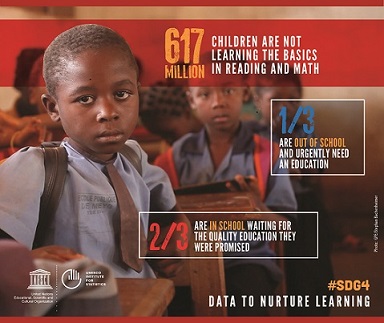Launch of the SDG 4 Data Digest: Data to Nurture Learning
Share
03/12/2018
The UNESCO Institute for Statistics (UIS) is launching the SDG 4 Data Digest 2018: Data to Nurture Learning, which demonstrates how data can contribute to improve learning, as ministers and policymakers gather at the Global Education Meeting in Brussels to take stock of progress towards Sustainable Development Goal 4 (SDG 4) on quality education for all.

“Far from being hidden away or hard to reach, these children are sitting in classrooms, waiting for schools to deliver the quality education they have been promised,” says Silvia Montoya, UIS Director. “That promise has been broken far too often.”
This matters, given the critical importance of learning for the achievement of all SDGs, from reducing poverty to tackling gender discrimination and building healthy, peaceful societies. The Digest raises concerns about how these goals can be reached by the 2030 deadline if significant numbers of people continue to lack basic skills.

The Digest highlights positive progress, with the Global Alliance to Monitor Learning (GAML) supporting national strategies for learning assessments and developing internationally-comparable indicators and methodological tools to measure progress towards SDG 4. It also provides tools and methodologies to help countries make informed decisions about the types of assessments that will meet their own needs, as well as guidance on participating in assessments and building the human capacity to improve learning outcomes through the effective use of data.
Making a strong investment case, the Digest argues for a shift in perspectives about the perceived costs of learning assessments from both donors and governments. Participation in major international or region-wide assessments can cost each country roughly $500,000 every four years, which seems like a major expense for a smaller economy. However, it is minor when set against the overall cost of providing schooling, and the even greater cost of a lack of education. The UIS estimates that solid data on learning to gauge whether approaches are working or whether reforms are needed could improve education spending efficiency by 5%, saving $30 million each year in the average country and paying for the cost assessments hundreds of times over.